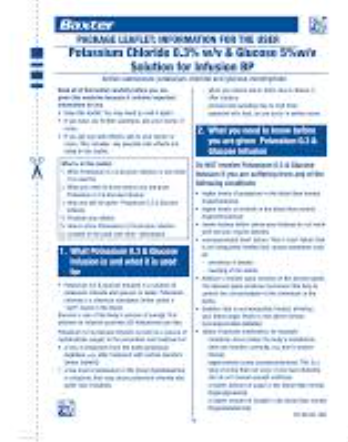
(BAXTER) Glucose 5% w/v and Potassium Chloride 0.3 % w/v Price
Active Substance: Potassium chloride, Glucose Monohydrate.
Overview
Welcome to Dwaey, specifically on (BAXTER) Glucose 5% w/v and Potassium Chloride 0.3 % w/v page.
This medicine contains an important and useful components, as it consists of
Potassium chloride, Glucose Monohydrateis available in the market in concentration
Name
Potassium chloride, Glucose Monohydrate
Precaution
<p> Administration of potassium chloride with glucose monohydrate requires vigilant clinical supervision due to the potential risk of electrolyte disturbances, especially hyperkalemia. Monitor serum potassium levels, renal function, and glucose regularly during treatment. This solution should be used cautiously in patients with cardiovascular disease, renal impairment, diabetes mellitus, or acid-base disorders. Rapid infusion or use in patients with compromised renal excretion may result in life-threatening cardiac arrhythmias. Avoid extravasation during IV administration due to the risk of local tissue necrosis. Use with caution in patients on digitalis therapy, as potassium fluctuations can potentiate toxicity. Avoid concurrent administration with other potassium-sparing drugs unless under specialist supervision. </p>
Indication
<p> This combination is indicated for the prevention and treatment of hypokalemia and dehydration in patients unable to tolerate oral intake. It is also used to provide a source of calories in the form of glucose, along with potassium supplementation. Typical indications include gastrointestinal losses (e.g., vomiting, diarrhea), prolonged fasting, nasogastric suction, diuretic therapy, diabetic ketoacidosis (post-insulin therapy), and fluid/electrolyte management in postoperative and critical care patients. </p>
Contra indication
<p> Contraindications include hyperkalemia, severe renal insufficiency, untreated Addison’s disease, anuria, acute dehydration, and conditions with potassium retention. It is also contraindicated in patients with glucose intolerance syndromes such as uncontrolled diabetes mellitus, hyperosmolar states, or patients at risk for fluid overload or pulmonary edema. Avoid in patients with known hypersensitivity to any component of the formulation. </p>
Side Effect
<p> Common adverse effects include injection site irritation, phlebitis, and local pain. Systemic side effects may include hyperkalemia (muscle weakness, paresthesia, cardiac arrhythmias), hyperglycemia, fluid overload, and metabolic acidosis. In rare cases, anaphylactic reactions may occur. Close monitoring is essential to avoid toxicity, especially during prolonged or high-dose administration. </p>
Pregnancy Category ID
Information not available
Mode of Action
<p> Potassium chloride restores normal serum potassium levels, which are essential for cellular membrane potential, neuromuscular function, and enzyme activity. Glucose monohydrate provides a rapidly available source of energy and helps prevent ketosis by sparing protein and fat catabolism. Together, they replenish intracellular and extracellular electrolyte balance and support metabolic energy requirements during parenteral therapy. </p>
Interaction
<p> Concomitant use with potassium-sparing diuretics (e.g., spironolactone, amiloride), ACE inhibitors, ARBs, NSAIDs, or cyclosporine increases the risk of hyperkalemia. Digitalis toxicity may be exacerbated by potassium imbalances. Use with corticosteroids may increase sodium retention and potassium loss. Insulin promotes cellular uptake of potassium and glucose, potentially leading to hypokalemia during co-administration. </p>
Pregnancy Category Note
<p> Pregnancy Category C. Potassium and glucose solutions should be used during pregnancy only if clearly needed and under medical supervision. While both components are generally safe when administered correctly, excessive doses may alter maternal or fetal electrolyte balance. Monitoring is essential, especially during labor or in gestational diabetes. </p>
Adult Dose
<p> The dose is individualized based on clinical condition, serum potassium, and glucose levels. For potassium: 20–40 mEq/day IV in mild to moderate deficiency; up to 200 mEq/day in severe cases with continuous ECG monitoring. For glucose: 500–1000 ml/day of 5% glucose solution provides 25–50 g glucose. Infusion rates should not exceed 10 mEq potassium/hour (up to 20 mEq/hour with ECG monitoring). </p>
Child Dose
<p> Pediatric dosing must be carefully calculated based on weight and clinical need. Usual potassium dose: 2–3 mEq/kg/day IV, not exceeding 0.5 mEq/kg/hour. Glucose requirements vary by age and metabolic demand. Monitor serum electrolytes and glucose closely during therapy. Always dilute appropriately and administer via infusion pump. </p>
Renal Dose
<p> In patients with renal impairment, potassium supplementation must be reduced or withheld due to impaired excretion and high risk of hyperkalemia. Dose adjustments are made based on serum potassium levels and renal function. Avoid if anuria or severe oliguria is present. Use under nephrology supervision is advised. </p>
Administration
<p> Administer by intravenous infusion only. The solution should be infused slowly via a controlled IV pump. Use a central or large peripheral vein to minimize vein irritation. Ensure compatibility with other IV medications before co-administration. Do not administer undiluted potassium chloride intravenously. Always inspect the solution for particulate matter and clarity before use. Discard any unused portion after a single-use. </p>
